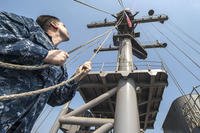If the Coast Guard's only heavy icebreaker suffers a major mechanical failure, Coast Guard research missions will be affected, but Navy operations in the Arctic would likely see little change, the Navy's head of acquisition told a lawmaker last week.
In response to questions from Rep. Duncan Hunter, R-Calif., about the aging icebreaker Polar Star, Assistant Secretary of the Navy for Research, Development and Acquisition Sean Stackley wrote in an Aug. 31 letter that a "catastrophic mechanical failure" for the Polar Star would limit the Coast Guard's icebreaking capability to its only medium icebreaker, the Healy, commissioned in 1999.
"This would likely be insufficient to execute the Coast Guard's icebreaking missions, most notably resupplying the National Science Foundation's scientific research stations in the Antarctic," Stackley wrote. He added that naval scientific research in the polar regions would also likely be reduced, and the Coast Guard's ability to "self-rescue" if something happened to the Healy would be compromised.
But such a loss would have minimal impact on the Navy, as naval Arctic missions primarily use undersea and air assets.
"With the exception of two Combat Logistics Force ship classes, Navy's current surface combatants are not capable of operating in the extreme harsh environment of sea-ice conditions, even with the support of a Coast Guard icebreaker," Stackley wrote.
Instead, he said, Navy Arctic surface operations take place during summer, when the most ice has melted. While the possibility of making Navy surface ships ice-resistant is being explored, this would require significant investment, and there are no plans currently on the table to make it happen, Stackley said.
The Polar Star was first commissioned in 1976, and overhauled in 2012 in an effort to add more years to the ship's projected 30-year service life.
Adding more icebreakers to the Coast Guard's fleet has been a top priority for the service, and a concern about which Hunter has been outspoken.
In a June op-ed in Navy Times, Hunter wrote that he was concerned the U.S. icebreaker gap risked losing key naval advantage to Russia in the Arctic. This summer, Russia launched its largest-ever icebreaker, the Arktika, set for completion in 2017. The country plans to complete two more massive icebreakers by the end of the decade.
The Coast Guard's current plan calls for the start of construction on a new icebreaker by 2020.
"The Navy supports the Coast Guard's plan to recapitalize heavy icebreaking capability over the next decade," Stackley wrote. "We are working with the Coast Guard to identify schedule efficiencies that may further accelerate the design and production timeline of the new icebreaker."









